Southern Natural Gas Company LLC:
Moody station:
Continue reading
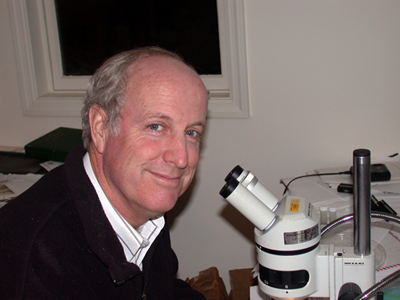 Nature is not something
out there, apart from people.
It never was, and nowadays people have built and farmed and clearcut
so much that wildlife species from insects to birds are in trouble.
In south Georgia people may think that our trees make a lot of wildlife habitat.
Actually, most of those trees are planted pine plantations with
very limited undergrowth, and in town many yards are deserts of grass
plus exotic species that don’t support native birds.
Douglas Tallamy offers one solution:
turn yards into wildlife habitat by growing native species.
Since we are as always remodeling nature, we might as well do it
so as to feed the rest of nature and ourselves,
and by the way get flood prevention and possibly cleaner water as well,
oh, and fewer pesticides to poison ourselves.
Nature is not something
out there, apart from people.
It never was, and nowadays people have built and farmed and clearcut
so much that wildlife species from insects to birds are in trouble.
In south Georgia people may think that our trees make a lot of wildlife habitat.
Actually, most of those trees are planted pine plantations with
very limited undergrowth, and in town many yards are deserts of grass
plus exotic species that don’t support native birds.
Douglas Tallamy offers one solution:
turn yards into wildlife habitat by growing native species.
Since we are as always remodeling nature, we might as well do it
so as to feed the rest of nature and ourselves,
and by the way get flood prevention and possibly cleaner water as well,
oh, and fewer pesticides to poison ourselves.
Douglas Tallamy makes a clear and compelling case in
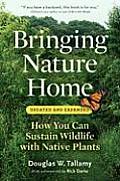 Bringing Nature Home: How You Can Sustain Wildlife with Native Plants
Bringing Nature Home: How You Can Sustain Wildlife with Native Plants
…it is not yet too late to save most of the plants and animals that sustain the ecosystems on which we ourselves depend. Second, restoring native plants to most human-dominated landscapes is relatively easy to do.
Some of you may wonder why native species are so important? Don’t we have more deer than we can shoot? Maybe so, but we have far fewer birds of almost every species than we did decades and only a few years ago.
Some may wonder: aren’t exotic species just as good as native ones,
if deer and birds can eat them?
Actually, no, because many exotic species are poisonous
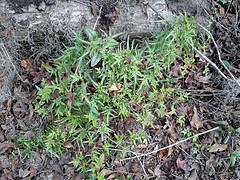 to native wildlife, and because invasive exotics crowd out natives
and reduce species diversity.
From kudzu to
Japanese climbing fern, exotic invasives are bad for wildlife
and may also promote erosion and flooding by strangling native vegetation.
to native wildlife, and because invasive exotics crowd out natives
and reduce species diversity.
From kudzu to
Japanese climbing fern, exotic invasives are bad for wildlife
and may also promote erosion and flooding by strangling native vegetation.
All plants are not created equal, particularly in their ability to support wildlife. Most of our native plant-eaters are not able to eat alien plants, and we are replacing native plants with alien species at an alarming rate, especially in the suburban gardens on which our wildlife increasingly depends. My central message is that unless we restore native plants to our suburban ecosystems, the future of biodiversity in the United States is dim.
Tallamy had an epiphany when he and his wife moved to 10 acres in Pennsylvania in 2000:
Continue readingZucca, okra, and sweet potatoes to Valdosta Farm Days this morning, 9AM to 1PM (and pumpkins and peppers), down at the historic Lowndes County Courthouse, Central Avenue between Patterson and Ashley.


 Where did she get those zucca?
The dogs helped.
Where did she get those zucca?
The dogs helped.
John S. Quarterman, Gretchen Quarterman,
Brown Dog, Yellow Dog,
Pictures and videos by John S. Quarterman for Okra Paradise Farms, Lowndes County, Georgia, 1 September 2012.
-jsq
Acording to U.S. Drought Monitor, drought throughout south Georgia and surrounding areas is either extreme or exceptional, and has been for months.
Here you can see detail for Georgia:
Continue readingThe only well in the Withlacoochee, Little, or Alapaha River watersheds that seems to be instrumented for near-realtime depth measurements is in Valdosta. That well is now at historic lows, compared to 55 years of back data.
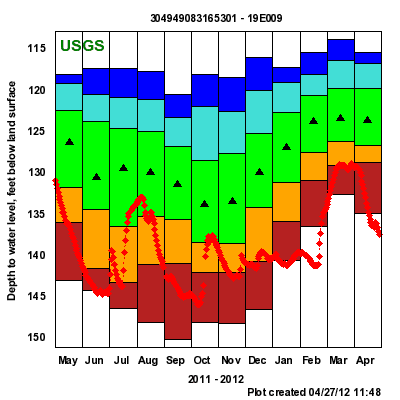 On the
graph to the right, the black triangle in the middle of the green is the median over those 55 years since 1957. The green is 25th to 75th percentile. The yellow is 10th to 24th percentile. The red is below 10th percentile. I’m guessing below the red means never been seen that low before in that month.
On the
graph to the right, the black triangle in the middle of the green is the median over those 55 years since 1957. The green is 25th to 75th percentile. The yellow is 10th to 24th percentile. The red is below 10th percentile. I’m guessing below the red means never been seen that low before in that month.
The current depth shown, 137.52 feet below the surface on 26 April 2012, is not the lowest ever seen, which was 152.31 feet on 19 September 1990. But apparently it is lower than seen before for April.
Maybe we should think about water conservation more frequently than just when Valdosta’s water pumps have problems. Not just for watering lawns; also for agriculture and silviculture. Maybe we should try to plant crops that don’t require as much irrigation, or plant them in ways that don’t lead to so much evaporation. Maybe we should be more careful about clearcutting trees, which causes rapid runoff that doesn’t get back into the groundwater as much. Maybe we should think about how much growth do we want.
-jsq
We’re on Georgia Water Coalition’s Dirty Dozen 2011: as 9. South Georgia Wetlands: Four Decades of Ditches Dry Out South Georgia Wetlands:
Since the 1970s, state and federal regulatory agencies have allowed the destruction of more than 200,000 acres of highly critical wetlands throughout South Georgia to increase timber production and agricultural yields and usher in residential and commercial development. These wetlands that captured water and slowly released it to streams no longer perform that important function. The result has been increased floods when it rains and record low flows when it doesn’t….
Flooding? Like the 700 year flood in Lowndes County 3 years ago today?
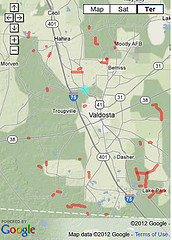
What’s a wetland, anyway?
the greatest concentration of wetlands is in the Coastal Plain of South Georgia. Though these forested foodplains and wetlands may not seem directly linked to our rivers and streams, they play an important role in holding water during rain events and dispensing it during dry periods. The sponges and kidneys of our state, they mitigate major floods, lessen the impacts of drought, and clean the water that passes through them, while regulating the amount of freshwater entering Georgia’s coastal estuaries where commercially important seafood find critical habitat. Additionally, these wetlands provide important habitat for waterfowl and other wildlife.
So what’s the problem?
In an effort to convert these wild lands intoContinue reading
 Janisse Ray plans
to speak in Moultrie and sign books.
Janisse Ray plans
to speak in Moultrie and sign books.
The Georgia Center for the Book, with the support of the Georgia Humanities Council, is working with the Moultrie-Colquitt County Library System and the Moultrie Chapter of the Georgia Conservancy to present a free public lecture and book-signing by Ray on Tuesday, Jan. 26, at 7 p.m., in the library auditorium.Why should you care?Ray was born in Baxley, Ga., and is an environmentalist activist, poet, a memoirist and the award-winning author of “Ecology of a Cracker Childhood.” This book, a memoir about growing up on a junkyard in the ruined longleaf pine ecosystem of the Southeast, was published by Milkweed Editions in 1999.

Ray has won a Southeastern Booksellers Award 1999, an American Book Award 2000, the Southern Environmental Law Center 2000 Award for Outstanding Writing, and a Southern Book Critics Circle Award 2000. “Ecology of a Cracker Childhood” was a New York Times Notable Book and was chosen as the Book All Georgians Should Read.Are you tired of development trumps all? Do you like trees and home-grown vegetables? Come hear Janisse Ray!As an organizer and activist, she works to create sustainable communities, local food systems, a stable global climate, intact ecosystems, clean rivers, life-enhancing economies, and participatory democracy. She is a founding board member of Altamaha Riverkeeper and is on the board of the Environmental Leadership Center of Warren Wilson College and Satilla Riverkeeper.
 In today’s VDT Upset about development:
In today’s VDT Upset about development:
Bill Herndon and his neighbors are unhappy about a development being built in their backyards.Marvin Peavy, now why does that name ring a bell? Ah, yes, CEO and CFO of Lower Lowndes, Inc. the corporation that bought 62.53 acres on Quarterman Road and attempted to rezone it from E-A to R-21 back in 2007. One of the neighbors saw the sign out front and a bunch of us helped convince the County Commission to deny the rezoning.Marvin Peavy, owner of Peavy Properties, has already rented some of the Mar-Mel-Go apartments, and about 70 of the projected 150 apartments have been completed. The other 80 units are scheduled to be added soon.
The two-story apartment buildings rise uncomfortably close to the homes of Pinebrook Drive residents, such as Herndon. Windows of the complex look directly into their backyards and homes.
This time it’s so bad another developer is complaining:
Robert Eddington also lives on Pinebrook Drive. He is a builder and said everyone has a right to develop their property. What he’s disturbed about, among other issues, is that the plans they were shown are not being followed. Eddington was told most of the trees would be spared to protect their privacy, but when he came home several days later, they were all gone except a few.Hm, given that the ULDC got changed a year or so back to require notification of rezoning mailed to adjoining property owners, in addition to a notice in the newspaper and a sign out front, if there was no sign and neighbors didn’t get notices, I wonder if there’s a legal problem with the rezoning.…
Eddington and his neighbors successfully fought a similar development on nearby Water Oak Drive four years ago. They had no such opportunity this time, he said. No notices of any hearing were posted. Neither Herndon nor Fuhrer saw any notices posted announcing zoning or development hearings by the Lowndes County Board of Commissioners.
Ah, this takes me back:
Eddington’s fence was damaged during Mar-Mel-Go construction. When contractors finally fixed it 17 months later, he said his wife asked about the gate that was supposed to be installed. The site manager told his wife that it wouldn’t be installed until the rest of the apartments were completed. Eddington said they were originally told these would be “luxury condos,” but are very different from the way they were described.The previous subdivision (not Peavy’s) that did get built on Quarterman Road (because its zoning was grandfathered in way back in the 1980s) involved a builder shoving building trash through my fence into my field. And streetlights that were installed by the developer but never turned on until the subdivision residents got the Commission to institute a special tax district to pay for them.
Curious how yet again “the plans they were shown are not being followed.”
Maybe if the neighbors go to the county they’ll get redress:
Herndon and his neighbors pooled their money several years ago and spent $4,400 to pave Pinewood Drive, so they feel they have a stake in how the road is used. He approached the Lowndes County Commission about the residents’ concerns and was eventually connected with County Engineer Mike Fletcher.Ah, finger pointing! Not the county government’s problem; it’s up to the property owner. Nevermind the county commission approved the development with certain plans and requirements.Fletcher said a $30,000 siren-controlled gate would be installed on Pinewood Drive for emergency vehicle access only, eliminating unwanted traffic through their neighborhood. The property owner is responsible for installing the gate, said Kevin Beals, Lowndes County development reviewer.
Well, maybe if the neighbors escalate to the county manager:
Lowndes County Manager Joe Pritchard said he thinks Pinebrook Drive residents “have some legitimate questions and we ought to be able to provide a reasonable answer.” Pritchard said he plans to meet with County Engineer Mike Fletcher and Zoning Administrator Carmella Braswell on Monday to discuss the development and see what remedies might be available.Yes, we’ve seen that process many times before. Note he doesn’t say they’ll provide any actual fixes to any of the problems, just “a reasonable answer”. We’ll see if these neighbors get any satisfaction this time.
According to the County Commission calendar, there’s a work session coming up Monday 13 July at 8:30AM and a commission meeting coming up Tuesday 14 July at 5:30PM. The Tuesday public meetings always have an agenda item for Citizens Wishing to the Heard. The work sessions usually don’t, but if you go you can hear what the commissioners have to say about subjects that have come before them, and often you can talk to them directly before or after the meeting.
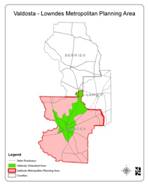 Another interesting thing from the Valdosta Transit Public Information Meeting was I was reminded of the Valdosta Urbanized Area. As you can see by the map, it extends all the way up Bemiss Road through Moody Air Force Base into Berrien County. This came up in the context of bus lines. Valdosta can run a bus to Moody, because Moody is in the Valdosta Urbanized Area.
Another interesting thing from the Valdosta Transit Public Information Meeting was I was reminded of the Valdosta Urbanized Area. As you can see by the map, it extends all the way up Bemiss Road through Moody Air Force Base into Berrien County. This came up in the context of bus lines. Valdosta can run a bus to Moody, because Moody is in the Valdosta Urbanized Area.
In a larger context, local public officials often wonder aloud how they can keep landowners from selling out and developers from developing all over the county. Well, they can’t actually prevent that. (Except they already have in the Moody Exclusion Zone immediately around the AFB, but that’s not the point; in general they can’t.) But they can encourage developers not to go for cheap land way out on the edges of the county, and instead buy land near existing services (water, wastewater, busses, etc.). Cheap hookups, expedited permits, encouragement by local municipalities; these things can all help steer development.
Lowndes County and the city of Valdosta could even designate a Preferred Development Corridor and steer development there. It already exists: Valdosta up Bemiss Road towards Moody, plus the area in and around Valdosta, especially along I-75. What’s missing is official and unofficial encouragement for developers to develop there.
In addition, I keep hearing people saying there’s no farming left in Lowndes County. That’s just not true. It’s not like it was 50 years ago, sure, but there are people actively farming, and even seeking new land to rent. South Carolina promotes farming as its growth business. Lowndes County is big enough to promote both industry and farming.